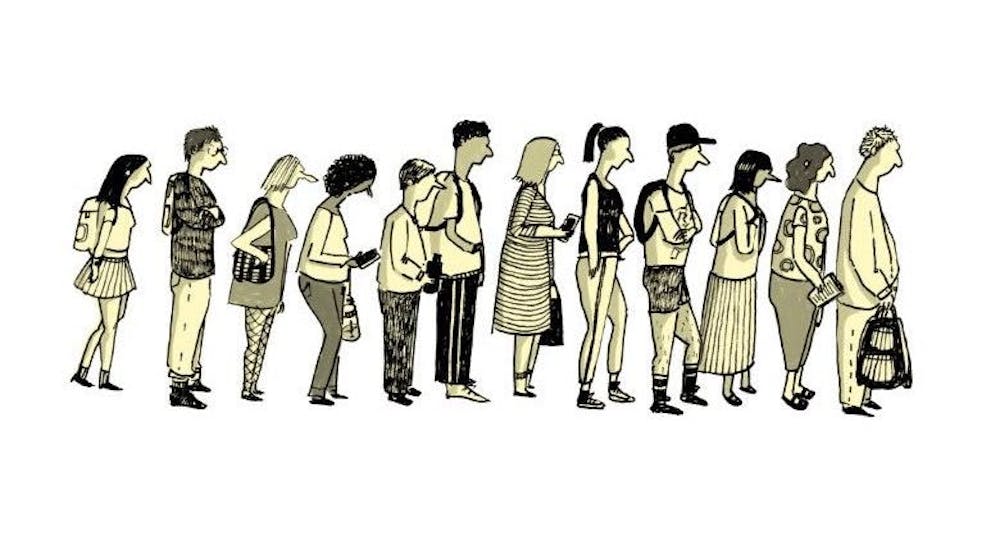Just one week into the Fall semester, a sense of crowdedness has overtaken Middlebury’s campus. Classrooms feel more packed than in years past, peaktime mailroom queues extend outside McCullough, and dining hall lines feel longer than ever.
Despite its marketable emphasis on the value of smaller, intimate educational settings, Middlebury has a growing student body that appears to be creating an increasingly inflexible student life framework, threatening to jeopardize some of the more intimate aspects of campus culture in the process.
In 2018, a total of 765 students accepted Middlebury’s offer of admission and enrolled at the College as members of the Class of 2022, the highest number of students to accept admission in college history. This year’s yield rate of 45.1 percent is 2.3 percent higher than that of 2017, a year when students already began to notice that campus was feeling overcrowded.
Traditionally, many students choose Middlebury College for its small student-to-faculty ratio. Indeed, admissions materials emphasize professor availability and course flexibility as defining characteristics of the college’s small liberal arts culture.
Professors have already noted effects of this year’s over-enrollment. “It does feel like I have more students showing up to add and fewer students ready to drop a spot in a class,” American Studies professor Deb Evans said in an email.
Professors are now forced to make a difficult choice: either reject students hoping to add their class or agree to excessive amounts of grading and class preparation.
“I feel terrible having to turn students away,” Evans said. “In that sense, it’s harder.”
An expanding student population poses additional problems for common areas on campus, particularly in first-year residence halls.
Many former common spaces in dorms such as Battell, Hepburn and Coffrin have been converted into sleeping spaces as a way to accommodate over-enrollment. These room conversions both prompt overcrowding in the few common areas that remain and decrease the total number of social spaces accessible to first-year students.
Based on the experiences of this editorial board, common areas play a central role in the first year experience, allowing for students to develop close, personal relationships with one another.
The fact that these spaces are being lost due to enrollment numbers forces us to question whether recent over-enrollment will be detrimental to new students’ experiences as they attempt to situate themselves in their new home.
Dining halls have also confronted the negative repercussions of a larger student body. Lunch lines have become unreasonably long and frantic, forcing staff members to work overtime to accommodate increased demand. Last week, during the notorious Thursday 12:15 p.m. lunch rush, Atwater Dining Hall staff stopped scanning students’ IDs to avoid making lines longer. Further, dining employees no longer have time to spend conversing with students.
“Sometimes [the dining rush gets] so crazy that you can’t get to know students,” said Proctor Manager Dawn Boise, “and my staff would like to.”
In that same vein, simple errands, like picking up a package at the mail center, can become challenging. Last Friday afternoon before the mail center closed for the weekend, students rushed to pick up their packages. A line formed at the mail center and stretched outside of McCullough and around the building.
While it’s certainly tiresome to have to wait in a line for half an hour after a day of class, what deserves most attention is the effects on the mail room staff whose job it is to process packages; when lines stretch down the hall and outside day after day, their job becomes more taxing than it likely should be. Though the beginning of the year is traditionally a busy time at the mail center, this year seems to be a special case.
A larger freshman class certainly provides a set of campus-wide advantages, specifically increased extracurricular participation, additional admission opportunities for diverse and first generation students, in addition to more overall social engagement. That this year’s freshman class was the most diverse in the college’s history should not be ignored, and the financial upside to admitting more students is understandable. However, this school’s population appears to be growing at a rate that encroaches upon the intimacy that is fundamental to the liberal arts experience.
We encourage the administration to be more aware of the ways in which over-enrollment has begun to affect our campus and the intimacy traditionally associated with it. If Middlebury is to preserve the essential aspects of a small liberal arts culture, it should not continue to increase enrollment without first implementing additional measures to adequately accommodate that growth.
Correction: An earlier version of this editorial said that the student-to-faculty ratio had increased from 8:1 to 9:1. This number was based on a fact sheet found on the college's admissions webpage. A college spokesman informed The Campus that this is not true and the college has no intention of seeing the ratio increase. The ratio remains 8:1 and it has since been corrected on the college website.
Where Did the Small School Go?

Comments

